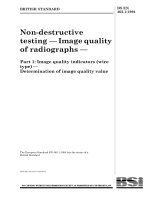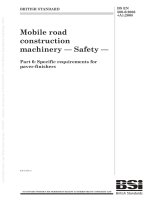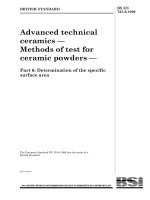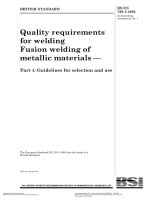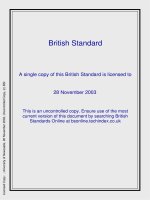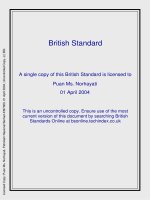Bsi bs en 60870 6 701 1998
Bạn đang xem bản rút gọn của tài liệu. Xem và tải ngay bản đầy đủ của tài liệu tại đây (387.52 KB, 22 trang )
BRITISH STANDARD
Telecontrol equipment
and systems —
Part 6-701: Telecontrol protocols
compatible with ISO standards and
ITU-T recommendations —
Functional profile for providing the
TASE.1 application service in end
systems
The European Standard EN 60870-6-701:1998 has the status of a
British Standard
ICS 33.200
BS EN
60870-6-701:
1998
IEC
60870-6-701:
1998
BS EN 60870-6-701:1998
National foreword
This British Standard is the English language version of
EN 60870-6-701:1998. It is identical with IEC 60870-6-701:1998.
The UK participation in its preparation was entrusted to Technical Committee
PEL/57, Power system control and communications, which has the
responsibility to:
— aid enquirers to understand the text;
— present to the responsible international/European committee any
enquiries on the interpretation, or proposals for change, and keep the UK
interests informed;
— monitor related international and European developments and
promulgate them in the UK.
A list of organizations represented on this committee can be obtained on
request to its secretary.
From 1 January 1997, all IEC publications have the number 60000 added to
the old number. For instance, IEC 27-1 has been renumbered as IEC 60027-1.
For a period of time during the change over from one numbering system to the
other, publications may contain identifiers from both systems.
Cross-references
Attention is drawn to the fact that CEN and CENELEC standards normally
include an annex which lists normative references to international
publications with their corresponding European publications. The British
Standards which implement international or European publications referred
to in this document may be found in the BSI Standards Catalogue under the
section entitled “International Standards Correspondence Index”, or by using
the “Find” facility of the BSI Standards Electronic Catalogue.
A British Standard does not purport to include all the necessary provisions of
a contract. Users of British Standards are responsible for their correct
application.
Compliance with a British Standard does not of itself confer immunity
from legal obligations.
Summary of pages
This document comprises a front cover, an inside front cover, pages i and ii,
the EN title page, pages 2 to 16, an inside back cover and a back cover.
This standard has been updated (see copyright date) and may have had
amendments incorporated. This will be indicated in the amendment table on
the inside front cover.
This British Standard, having
been prepared under the
direction of the Electrotechnical
Sector Committee, was
published under the authority
of the Standards Committee
and comes into effect on
15 December 1998
© BSI 05-1999
ISBN 0 580 30896 0
Amendments issued since publication
Amd. No.
Date
Comments
BS EN 60870-6-701:1998
Contents
National foreword
Foreword
Text of EN 60870-6-701
© BSI 05-1999
Page
Inside front cover
2
5
i
ii
blank
EUROPEAN STANDARD
EN 60870-6-701
NORME EUROPÉENNE
October 1998
EUROPÄISCHE NORM
ICS 33.200
Descriptors: Open systems interconnection, telecontrol, application service element, functional profile, end system
English version
Telecontrol equipment and systems
Part 6-701: Telecontrol protocols compatible with
ISO standards and ITU-T recommendations Functional
profile for providing the TASE.1 application service in end
systems
(IEC 60870-6-701:1998)
Matériels et systèmes de téléconduite
Partie 6-701: Protocoles de téléconduite
compatibles avec les normes ISO et les
recommandations de l’UIT-T
Profils fonctionnels pour fournir le
service d’application TASE.1 dans des
systèmes terminaux
(CEI 60870-6-701:1998)
Fernwirkeinrichtungen und -systeme
Teil 6-701: Fernwirkprotokolle, die mit
ISO-Normen und ITU-T-Empfehlungen
kompatibel sind
Funktionsprofil für den TASE.1Anwendungsdienst in Endsystemen
(IEC 60870-6-701:1998)
This European Standard was approved by CENELEC on 1998-10-01.
CENELEC members are bound to comply with the CEN/CENELEC Internal
Regulations which stipulate the conditions for giving this European Standard
the status of a national standard without any alteration.
Up-to-date lists and bibliographical references concerning such national
standards may be obtained on application to the Central Secretariat or to any
CENELEC member.
This European Standard exists in three official versions (English, French,
German). A version in any other language made by translation under the
responsibility of a CENELEC member into its own language and notified to the
Central Secretariat has the same status as the official versions.
CENELEC members are the national electrotechnical committees of Austria,
Belgium, Czech Republic, Denmark, Finland, France, Germany, Greece,
Iceland, Ireland, Italy, Luxembourg, Netherlands, Norway, Portugal, Spain,
Sweden, Switzerland and United Kingdom.
CENELEC
European Committee for Electrotechnical Standardization
Comité Européen de Normalisation Electrotechnique
Europäisches Komitee für Elektrotechnische Normung
Central Secretariat: rue de Stassart 35, B-1050 Brussels
© 1998 CENELEC — All rights of exploitation in any form and by any means reserved worldwide for
CENELEC members.
Ref. No. EN 60870-6-701:1998 E
EN 60870-6-701:1998
Foreword
The text of document 57/357/FDIS, future edition 1
of IEC 60870-6-701, prepared by IEC TC 57, Power
system control and associated communications, was
submitted to the IEC-CENELEC parallel vote and
was approved by CENELEC as EN 60870-6-701
on 1998-10-01.
The following dates were fixed:
— latest date by which the EN
has to be implemented at
national level by
publication of an identical
national standard or by
endorsement
(dop) 1999-07-01
— latest date by which the
national standards
conflicting with the EN
have to be withdrawn
(dow) 2001-07-01
Annexes designated “normative” are part of the
body of the standard.
Annexes designated “informative” are given for
information only.
In this standard, Annex A and Annex ZA are
normative and Annex B is informative.
Annex ZA has been added by CENELEC.
Endorsement notice
The text of the International Standard
IEC 60870-6-701:1998 was approved by CENELEC
as a European Standard without any modification.
In the official version, for Annex B, Bibliography,
the following note has to be added for the standard
indicated:
IEC 60870-6-501
NOTE
2
Harmonized as EN 60870-6-501:1990 (not modified).
© BSI 05-1999
EN 60870-6-701:1998
Contents
Page
Foreword
2
Introduction
5
1
Scope
5
2
Normative references
6
3
Definitions
6
4
Abbreviations
6
5
Profile protocol stacks
6
6
Conformance requirements
7
6.1 TASE.1 requirements
7
6.2 Upper layers requirements
7
Annex A (normative) ISPICS requirements lists 8
A.1 General
8
A.2 Classification of requirements
8
A.3 TASE.1
9
A.4 ROSE
9
A.5 ACSE
9
A.6 Presentation
12
A.7 Session
13
Annex B (informative) Bibliography
16
Annex ZA (normative) Normative
references to international publications
with their corresponding European
publications
Inside back cover
Figure 1 — Applicability of the functional
profile
5
Figure 2 — TASE.1 application profile
6
Table A.1 — Protocol mechanisms
9
Table A.2 — Initiator/responder capability
10
Table A.3 — Normal mode APDUs
10
Table A.4 — A-associated-request APDU
10
Table A.5 — A-associated-response APDU
11
Table A.6 — A-release-request APDU
11
Table A.7 — A-release-response APDU
11
Table A.8 — Abort APDU
11
Table A.9 — AE title syntax name-form
alternatives
11
Table A.10 — Presentation PRL
12
Table A.11 — Connect Presentation
PPDU (CP)
12
Table A.12 — Connect Presentation
Accept (CPA)
12
Table A.13 — Connect Presentation Reject
PPDU (CPR)
13
Table A.14 — Abnormal Release User
PPDU (ARU)
13
© BSI 05-1999
Page
Table A.15 — Abnormal Release Provider
PPDU (ARP)
Table A.16 — Presentation Data
PPDU (PD)
Table A.17 — Session Protocol version
Table A.18 — Session functional units
Table A.19 — Session connection
Table A.20 — Orderly release
Table A.21 — Normal data transfer
Table A.22 — SPDUs associated with the
Kernel service
Table A.23 — Connect (CN) SPDU
Table A.24 — Accept (AC) SPDU
Table A.25 — Refuse (RF) SPDU
Table A.26 — Finish (FN) SPDU
Table A.27 — Disconnect (DN) SPDU
Table A.28 — Abort (AB) SPDU
Table A.29 — Data transfer (DT) SPDU
13
13
13
13
13
14
14
14
14
15
15
15
15
16
16
3
4
blank
EN 60870-6-701:1998
Introduction
This standard is one of the IEC 60870-6 series
defining functional profiles to be used in
telecommunication networks for electrical power
systems. It is largely based on existing ISO/IEC
International Standards and international
standardized profiles (ISP).
The notion of functional profiles is fundamental in
the organization of the publications of IEC 60870-6.
A description of functional profiles, their
classification scheme, and the manner of defining
them are laid down in IEC, 60870-6-1 [1]1).
The present standard TASE.1 application profile is
an application-class profile providing inter control
system communication to control system
applications. The TASE.1 protocol in the application
layer is specified in IEC 60870-6-501 [2], and the
TASE.1 application services are specified in
IEC 60870-6-502. The present standard refines the
TASE.1 to meet interoperability requirements and
specifies requirements on the presentation and
session layers. The TASE.1 operates in a connection
mode so this A-profile interfaces to a transport-class
profile of the T-profile variety.
1 Scope
This part of IEC 60870 desribes the functional
profile (FP) which defines the provision of the
TASE.1 communication services between two
control centre end systems. This functional profile is
supported by the transport services implemented in
accordance with transport profiles defined for the
type of network that interconnect the control centre
end systems. Figure 1 illustrates the applicability of
the functional profile.
Figure 1 — Applicability of the functional profile
1) The
numbers in square brackets refer to the bibliography given in Annex B.
© BSI 05-1999
5
EN 60870-6-701:1998
2 Normative references
The following normative documents contain
provisions which, through reference in this text,
constitute provisions of this part of IEC 60870. At
the time of publication, the editions indicated were
valid. All normative documents are subject to
revision, and parties to agreements based on this
part of IEC 60870 are encouraged to investigate the
possibility of applying the most recent editions of
the normative documents indicated below. Members
of IEC and ISO maintain registers of currently Valid
International Standards.
IEC 60870-6-502:1995, Telecontrol equipment and
systems — Part 6: Telecontrol protocols compatible
with ISO standards and ITU-T recommendations —
Section 502: TASE.1 protocol definitions.
ISO/IEC 8326:1987, Information processing
systems — Open Systems Interconnection — Basic
connection oriented session service definition.
ISO/IEC 8327:1987, Information processing
systems — Open Systems Interconnection — Basic
connection oriented session protocol specification.
ISO/IEC 8327-2:1996, Information technologies —
Open Systems Interconnection —
Connection-oriented session protocol — Protocol
implementation conformance statement (PICS)
proforma.
ISO/IEC 8649:1996, Information technologies —
Open Systems Interconnection — Service definition
for the Association Control Service Element (ACSE).
ISO/IEC 8650:1988, Information processing
systems — Open Systems Interconnection —
Protocol Specification for the Association Control
Service Element (ACSE).
ISO/IEC 8650-2:1995, Information technology —
Open Systems Interconnection — Protocol
Specification for the Association Control Service
Element — Protocol Implementation Conformance
Statement (PICS) proforma.
ISO/IEC 8822:1994, Information technology — Open
Systems Interconnection — Presentation service
definition.
ISO/IEC 8823:—, Information technology — Open
Systems Interconnection — Connection-oriented
presentation protocol.
ISO/IEC 8823-2:1995, Information technology —
Open Systems Interconnection —
Connection-oriented presentation protocol —
Protocol Implementation Conformance Statement
(PICS) proforma.
ISO/IEC 9072-2:1989, Information processing
systems — Text communication — Remote
operations — Part 2: Protocols specification.
3 Definitions
For the purpose of this part of IEC 60870, the terms
defined in the standards given in clause 2 are
applicable.
4 Abbreviations
For the purposes of this part of IEC 60870, the
abbreviations defined in the standards given in
clause 2 are applicable.
5 Profile protocol stacks
As shown in Figure 2, the TASE.1 profile includes
the TASE.1, ROSE, and ACSE elements, the
Connection-Mode Presentation protocol, and the
Connection-Mode Session protocol.
Figure 2 — TASE.1 application profile
6
© BSI 05-1999
EN 60870-6-701:1998
6 Conformance requirements
The ISPICS requirements lists for TASE.1, ROSE,
ACSE, Presentation, and Session are given
in Annex A.
For each implementation claiming conformance to
this part of IEC 60870 an appropriate set of PICSs
shall be made available stating support or
non-support of each option identified in this part of
IEC 60870.
6.1 TASE.1 requirements
There are no TASE.1 requirements besides those
specified in the conformance statement given in
IEC 60870-6-502.
6.2 Upper layers requirements
The presentation protocol shall be able to support
the Default Context Name option. The session
protocol used shall be version 2.
© BSI 05-1999
7
EN 60870-6-701:1998
Annex A (normative)
ISPICS requirements lists
A.1 General
This annex describes the TASE.1, ROSE, ACSE, Presentation, and Session requirements in terms of tables
which reference the base standard PICS proforma. The tables are intended to give a precise specification
of requirements. In case of arbitration or dispute, this annex takes precedence over clause 6 of this
standard.
In the PICS proforma reference column of the tables in this annex, and in the lists of conditional
expressions underneath the tables, tables within the base standard PICS proformas are referenced. The
first letter identifies the specific PICS proforma:
• TASE.1 — IEC 60870-6-502
• ROSE — ISO/IEC 9072-2
• ACSE — ISO/IEC 8650-2
• Presentation — ISO/IEC 8823-2
• Session — ISO/IEC 8327-2
The characters from the second character to the solidus form a reference to the specific subclause in the
annex of that PICS proforma which contains the table in question. The number after the solidus references
the row number in the table.
A.2 Classification of requirements
Throughout this annex, to specify the level of support for each feature, the following classification is used:
• Init-CR: Initiator Conformance Requirement
• Resp-CR: Responder Conformance Requirement
A.2.1 Base column
The “Base” column reflects the definitions and specifications in the appropriate base standard. Each entry
in this column is chosen from the following list:
• mandatory; m: that feature shall be supported, i.e. its syntax and procedures shall be implemented
as specified in the base standard. However, it is not a requirement that the feature shall be used in all
instances of communication, unless mandated by the base standard;
• optional; o: any feature denoted by “o” is left to the implementation as to whether that feature is
implemented or not. If a parameter is optionally supported, then the syntax shall be implemented, but
it is left to each implementation whether the procedures are implemented or not.
Where the base entry contains two classifications separated by a comma, these reference the sending and
receiving capabilities, respectively.
A.2.2 F/S Column
The “F/S” column reflects the requirements of this functional standard. Each entry in this column is chosen
from the following terminology:
• supported; m: any feature denoted by “m” is mandatory or optional in the base standard. That
feature shall be supported, i.e. its syntax and procedures shall be implemented as specified in the base
standard or in this ISP by all implementations claiming conformance to this document. However, it is
not a requirement that the feature shall be used in all instances of communication, unless mandated by
the base standard or stated otherwise in this profile;
• optionally supported; o: any feature denoted by “o” is left to the implementation as to whether that
feature is implemented or not. If a parameter is optionally supported, then the syntax shall be
implemented, but it is left to each implementation whether the procedures are implemented or not;
• conditionally supported; c: any feature denoted by “c” shall be supported under the conditions
specified in this standard. If these conditions are not met, the feature is outside the scope of this
standard;
• excluded; x: any feature denoted by “x” is excluded in this profile, i.e. an implementation shall
behave as if the feature is not implemented;
8
© BSI 05-1999
EN 60870-6-701:1998
• outside of scope; i: any feature denoted by “i” is outside the scope of this document, i.e. it may be
ignored, and will therefore not be subject to the profile conformance test. However, the syntax of all
parameters of supported PDUs shall be implemented, even if the procedures are not (i.e. the receiver
shall be able to decode the PDU);
• not applicable; –: any feature denoted by “–” is not defined in the context where it is mentioned,
e.g. a parameter which is not part of the respective PDU. The occurrence of “not applicable” features is
mainly due to the format of the tables in the ISPICS requirements list.
Where the F/S entry contains two classifications separated by a comma, these reference the sending and
receiving capabilities, respectively.
A.2.3 Status column
The status column reflects the classification to be found in the base standard PICS proforma:
o: optional
c: conditional
o.n: optional with at least one of the marked items being selected
The definitions of conditional items may be found in the respective PICS proformas.
Where the status entry contains two classifications separated by a comma, these apply to the sending and
receiving capabilities, respectively.
A.2.4 Profile column
The profile column reflects the requirement of this profile. Each entry in this column is chosen from the
following list:
m: mandatory support
c: conditional support
o.n: optional with at least one of the marked items being selected
i: outside the scope
–: not applicable
Where the profile entry contains two classifications separated by a comma, these reference the sending and
receiving capabilities, respectively.
A.3 TASE.1
Since IEC 60870-6-504 [3] is a technical report type 2 but not a standard, there are no TASE.1 particular
requirements for the present version of IEC 60870-6-701.
If necessary, this clause will be revised in the future according to the IEC 60870-6-502 and
IEC 60870-6-504 [3] updating.
A.4 ROSE
For the use of TASE.1, the system shall support the mapping of ROSE onto RTSE.
There are no other extra statement requirements than those needed for the ACSE implementation as
specified in clause A.5.
A.5 ACSE
A.5.1 Supported functions
Table A.1 — Protocol mechanisms
PICS proforma
reference
Protocol mechanism
Init-CR
Base
Resp-CR
F/S
Base
F/S
A.A.7/1
Normal mode
o.01
m
o.01
m
A.A.7/2
X.410-1984 mode
o.01
i
o.01
i
A.A.7/3
Rules for extensibility
m
m
m
m
A.A.7/4
Supports operation of Session V2
o
m
o
m
© BSI 05-1999
9
EN 60870-6-701:1998
A.5.2 Initiator/responder capability
Table A.2 — Initiator/responder capability
PICS proforma
reference
Capability
Init-CR
Base
Resp-CR
F/S
Base
F/S
A.A.8/1
Association initiator
o
m
o
i
A.A.8/2
Association responder
o
i
o
m
A.5.3 Supported normal mode APDUs
Table A.3 — Normal mode APDUs
PICS proforma
reference
APDU
Status
Profile
Init-CR
Resp-CR
A.A.9/1
A-associate-request (AARQ)
c
m, i
i, m
A.A.9/2
A-associate-response (AARE)
c
i, m
m, i
A.A.9/3
A-release-request (RLRQ)
o, m
m,i
i, m
A.A.9/4
A-release-response (RLRE)
m, c
i,m
m
A.A.9/5
A-abort (ABRT)
c
i
i
A.5.4 Supported normal mode parameters
Table A.4 — A-associated-request APDU
PICS proforma
reference
AARQ
Status
Profile
Init-CR
Resp-CR
A.A.10.1/1
Protocol version
c, m
m
m
A.A.10.1/2
Application context name
m
m
m
A.A.10.1/3
Calling AP title
o, m
m
m
A.A.10.1/4
Calling AE qualifier
o, m
m
m
A.A.10.1/5
Calling AE invocation-id
o, m
i
i
A.A.10.1/6
Calling AE invocation-id
o, m
i
i
A.A.10.1/7
Called AP title
o, m
m
m
A.A.10.1/8
Called AE qualifier
o, m
m
m
A.A.10.1/9
Called AP invocation-id
o, m
i
i
A.A.10.1/10
Called AE invocation-id
o, m
i
i
A.A.10.1/11
Implementation information
o, m
i
i
A.A.10.1/12
User information
o, m
m
m
10
© BSI 05-1999
EN 60870-6-701:1998
Table A.5 — A-associated-response APDU
PICS proforma
reference
AARE parameter
Status
Profile
Init-CR
Resp-CR
A.A.10.2/1
Protocol version
c, m
i,m
m,i
A.A.10.2/2
Application context name
m
m
m
A.A.10.2/3
Responding AP title
o, m
m
m
A.A.10.2/4
Responding AE qualifier
o, m
m
m
A.A.10.2/5
Responding AE invocation-id
o, m
i
i
A.A.10.2/6
Responding AE invocation-id
o, m
i
i
A.A.10.2/7
Result
m
m
m
A.A.10.2/8
Result source diagnostic
m
m
m
A.A.10.2/9
Implementation information
o, m
i
i
A.A.10.2/10
User information
m
m
Table A.6 — A-release-request APDU
PICS proforma
reference
RLRQ parameter
Status
Profile
Init-CR
Resp-CR
A.A.10.3/1
Reason
o, m
m
m
A.A.10.3/2
User information
o, m
m
m
Table A.7 — A-release-response APDU
PICS proforma
reference
RLRQ Parameter
Status
Profile
Init-CR
Resp-CR
A.A.10.4/1
Reason
o, m
m
m
A.A.10.4/2
User information
o, m
m
m
Table A.8 — Abort APDU
PICS proforma
reference
RLRQ Parameter
Status
Profile
Init-CR
Resp-CR
A.A.10.5/1
Reason
o, m
m
m
A.A.10.5/2
User information
o, m
m
m
A.5.5 AE title syntax name-form
Table A.9 — AE title syntax name-form alternatives
PICS proforma
reference
Syntax form
Sending
Base
Receiving
F/S
Base
F/S
A.A.11/1
Form 1 (Directory name)
o
i
m
m
A.A.11/2
Form 2 (Object Id and Integrator)
o
m
m
m
© BSI 05-1999
11
EN 60870-6-701:1998
A.6 Presentation
Table A.10 — Presentation PRL
PICS proforma
reference
Name of item
Status
Profile
Init-CR
Resp-CR
P.A.5.1/1
X.410 (1984)
o
i
i
P.A.5.1/2
Normal
o
m
m
P.A.5.2/1
Kernel functional unit
m
m
m
P.A.5.2/6
Duplex
o
m
m
P.A.5.2/2
Presentation Context management
functional unit
o
i
i
P.A.5.2/3
Presentation Context Restoration
functional unit
o
i
i
P.A.6.1.1.1/1
Initiator (presentation connection)
m
i
P.A.6.1.1.1/2
Responder (presentation connection)
i
m
P.A.6.1.1.2/1
Requestor (normal data)
m
m
P.A.6.1.1.2/2
Acceptor (normal data)
m
m
P.A.6.1.1.3/1
Requestor (orderly release)
m
m
P.A.6.1.1.3/2
Acceptor (orderly release)
m
m
A.6.1 PPDUs parameters
The level of support for PPDU parameters shall be coherent with the choice of session functional units and
the level of support of the SPDU parameters.
Table A.11 — Connect Presentation PPDU (CP)
PICS proforma
reference
Name of item
Status
Profile
Init-CR
Resp-CR
P.A.7.1/1
Calling presentation selector
o
m
m
P.A.7.1/2
Called presentation selector
o
m
m
P.A.7.1/3
Mode selector
m
m
m
P.A.7.1/4
Presentation context definition list
o
i
i
P.A.7.1/5
Default context name
o
m
m
P.A.7.1/6
Protocol version
m
m
m
P.A.7.1/7
Presentation requirements
o
i
i
P.A.7.1/8
User session requirements
o
m
m
P.A.7.1/9
User data
o
m
m
Table A.12 — Connect Presentation Accept (CPA)
PICS proforma
reference
Name of item
Status
Profile
Init-CR
Resp-CR
P.A.7.2/1
Responding presentation selector
o
i
i
P.A.7.2/2
Mode selector
m
m
m
P.A.7.2/3
Presentation context definition list
o
i
i
P.A.7.2/4
Protocol version
m
m
m
P.A.7.2/5
Presentation requirements
o
i
i
P.A.7.2/6
User session requirements
o
m
m
P.A.7.2/7
User data
o
m
m
12
© BSI 05-1999
EN 60870-6-701:1998
Table A.13 — Connect Presentation Reject PPDU (CPR)
PICS proforma
reference
Name of item
Status
Profile
Init-CR
Resp-CR
P.A.7.3/1
Responding presentation selector
o
i
i
P.A.7.3/2
Presentation context definition list
o
i
i
P.A.7.3/3
Protocol version
o
m
m
P.A.7.3/4
Default context result
o
i
i
P.A.7.3/5
Provider reason
o
i
i
P.A.7.3/6
User data
o
m
m
Table A.14 — Abnormal Release User PPDU (ARU)
PICS proforma
reference
Name of item
Status
Profile
Init-CR
Resp-CR
P.A.7.4/1
Presentation context definition list
o
i
i
P.A.7.4/2
User data
o
m
m
Table A.15 — Abnormal Release Provider PPDU (ARP)
PICS proforma
reference
Name of item
Status
Profile
Init-CR
Resp-CR
P.A.7.5/1
Provider reason
m
m
m
P.A.7.5/2
Event identifier
o,m
m
m
Table A.16 — Presentation Data PPDU (PD)
PICS proforma
reference
P.A.7.8/1
Name of item
Status
Profile
Init-CR
User data
m
m
Resp-CR
m
A.7 Session
Table A.17 — Session Protocol version
PICS proforma
reference
S.A.3/2
Name of item
Status
Profile
Init-CR
Version 2
o
m
Resp-CR
m
Table A.18 — Session functional units
PICS proforma
reference
Name of item
Status
Profile
Init-CR
Resp-CR
S.A.6.1/1
Kernel
m
m
m
S.A.6.1/4
Duplex
m
m
m
Table A.19 — Session connection
PICS proforma
reference
Name of item
Status
Profile
Init-CR
Resp-CR
S.A.7.1.1.1/1
Initiator
o
m
i
S.A.7.1.1.1/2
Responder
o
i
m
© BSI 05-1999
13
EN 60870-6-701:1998
Table A.20 — Orderly release
PICS proforma
reference
Name of item
Status
Profile
Init-CR
Resp-CR
S.A.7.1.1.2/1
Requestor
o
m
i
S.A.7.1.1.2/2
Acceptor
o
i
m
Table A.21 — Normal data transfer
PICS proforma
reference
Name of item
Status
Profile
Init-CR
Resp-CR
S.A.7.1.1.3/1
Requestor
m
m
m
S.A.7.1.1.3/2
Acceptor
m
m
m
Table A.22 — SPDUs associated with the Kernel service
PICS proforma
reference
Name of item
Status
Profile
Init-CR
Resp-CR
S.A.7.1.2/1
Connect (CN)
m
m
i
S.A.7.1.2/4
Accept (AC)
m
i
m
S.A.7.1.2/5
Refuse (RF)
m
i
m
S.A.7.1.2/6
Finish (FN)
m
m
i
S.A.7.1.2/7
Disconnect (DN)
m
i
m
S.A.7.1.2/8
Abort (AB)
m
m
m
S.A.7.1.2/5
Data Transfer (DT)
m
m
m
Table A.23 — Connect (CN) SPDU
PICS proforma
reference
Name of item
Status
Profile
Init-CR
S.A.8.1.1
Connection identifier PGI
o
S.A.8.1.2.1
Connect/accept item PGI
o
S.A.8.1.2.1/1
Protocol options
S.A.8.1.2.1/2
Resp-CR
i
i
m
m
m
TSDU maximum size
o
i
i
S.A.8.1.2.1/3
Version number
m
m
m
S.A.8.1.2.1/4
Initial serial number
o
i
i
S.A.8.1.2.1/5
Token setting item
o
i
i
S.A.8.1.2.1/6
Second initial serial number
o
i
i
S.A.8.1.3/1
Session user requirements
m
m
m
S.A.8.1.3/2
Calling session selector
o
i
i
S.A.8.1.3/3
Called session selector
m
m
m
S.A.8.1.3/4
Data overflow
i
i
i
S.A.8.1.3/5
User data
m
m
m
S.A.8.1.3/6
Extended user data
m
m
m
14
© BSI 05-1999
EN 60870-6-701:1998
Table A.24 — Accept (AC) SPDU
PICS proforma
reference
Name of item
Status
Profile
Init-CR
S.A.8.4.1
Connection identifier PGI
S.A.8.4.2.1
Connect/accept item PGI
S.A.8.4.2.1/1
Resp-CR
o
i
i
Protocol options
m
m
m
S.A.8.4.2.1/2
TSDU maximum size
o
i
i
S.A.8.4.2.1/3
Version number
m
m
m
S.A.8.4.2.1/4
Initial serial number
o
i
i
S.A.8.4.2.1/5
Token setting item
o
i
i
S.A.8.4.2.1/6
Second initial serial number
o
i
i
S.A.8.4.3/1
Token item
o
i
i
S.A.8.4.3/2
Session user requirements
m
m
m
S.A.8.4.3/4
Calling session selector
m
m
m
S.A.8.4.3/5
Responding session selector
o
i
i
S.A.8.4.3/6
User data
m
m
m
S.A.8.4.3/3
Table A.25 — Refuse (RF) SPDU
PICS proforma
reference
Name of item
Status
Profile
Init-CR
Resp-CR
S.A.8.5.1
Connection identifier PGI
o
i
i
S.A.8.5.2/1
Transport disconnect
o
i
i
S.A.8.5.2/2
Session user requirements
S.A.8.5.2/3
Version number
m
m
m
S.A.8.5.2/4
Enclosure item
m
m
m
S.A.8.5.2/5
Reason code
Table A.26 — Finish (FN) SPDU
PICS proforma
reference
Name of item
Status
Profile
Init-CR
Resp-CR
S.A.8.6/1
Transport disconnect
o
i
i
S.A.8.6/2
Enclosure item
m
m
m
S.A.8.6/3
Table A.27 — Disconnect (DN) SPDU
PICS proforma
reference
Name of item
Status
Profile
Init-CR
Resp-CR
S.A.8.7/1
Enclosure item
m
m
m
S.A.8.7/2
User data
o
m
m
© BSI 05-1999
15
EN 60870-6-701:1998
Table A.28 — Abort (AB) SPDU
PICS proforma
reference
Name of item
Status
Profile
Init-CR
Resp-CR
S.A.8.9/1
Transport disconnect
m
m
m
S.A.8.9/2
Enclosure item
m
m
m
S.A.8.9/3
Reflect parameter values
o
i
i
S.A.8.9/4
User data
m
m
m
Table A.29 — Data transfer (DT) SPDU
PICS proforma
reference
Name of item
Status
Profile
Init-CR
Resp-CR
S.A.8.11/1
Enclosure item
i
i
i
S.A.8.11/2
User information field
m
m
m
Annex B (informative)
Bibliography
[1] IEC 60870-6-1:1995, Telecontrol equipment and systems — Part 6: Telecontrol protocols compatible with
ISO standards and ITU-T recommendations — Section 1: Application context and organization of
standards.
[2] IEC 60870-6-501:1995, Telecontrol equipment and systems — Part 6: Telecontrol protocols compatible
with ISO standards and ITU-T recommendations — Section 501: TASE.1 service definitions.
[3] IEC 60870-6-504:1998, Telecontrol equipment and systems — Part 6: Telecontrol protocols compatible
with ISO standards and ITU-T recommendations — Section 504: User conventions.
[4] ISO/IEC 10000-1:1995, Information technology — Framework and taxonomy of International
Standardized Profiles — Part 1: General principles and documentation framework.
[5] ISO/IEC 10000-2:1995, Information technology — Framework and taxonomy of International
Standardized Profiles — Part 2: Principles and taxonomy of OSI Profiles.
16
© BSI 05-1999
